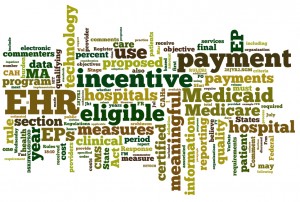noun, plural syn·er·gies.1.the interaction of elements that when combined produce a total effect that is greater than the sum of the individual elements,contributions, etc.; synergism.2.Physiology, Medicine/Medical . the cooperative action of two or more muscles, nerves, or the like.3.Biochemistry, Pharmacology . the cooperative action of two or more stimuli or drugs.
Synergy is often listed as one of the most hated words in the corporate world. However, achieving synergy between clinicians and health care technology is a crucial element in achieving return on investment.
I have rarely been in discussions, meetings, or presentations where people are discussing how clinicians and technology are going to work together to produce the best outcomes. Most commonly, the discussion is centered on how we are going to tweak the technology to suit the clinicians... or motivate the clinicians to use the existing technology. Sometimes, the impact on the patient is part of the discussion, but rarely- if ever- is the benefit to the institution included. The content of these discussions are exactly why most institutions have not seen the return on investment that they expected from their health care technology.
Achieving synergy between clinicians and technology is absolutely necessary. Here's why. Clinicians are good at being clinicians: ambiguity and the unknown are acceptable and expected parts of their decision making. Computers, on the other hand, are good at being computers: they excel at making consistent and accurate decisions when provided with a full set of data. Most health care delivery involves decision making on both ends of this spectrum. When computers provide consistent and accurate information to clinicians they are freed to make better decisions about the unknown. This facilitates optimal patient care, which of course benefits not only patients but creates value for institutions.
For anyone who has sat in a meeting like I described above, creating this needed synergy between clinicians technology may seem unlikely or even unattainable. The good news is that it is completely possible.
When I was involved in the project to decrease venous thromboembolism (VTE), it was clear to the team that interactions between clinicians and the EHR were synergistic. Recent research into the clinical decisions support tools we developed has actually quantified the effect of the synergy between providers and the EHR. While a computer-based algorithm could have been used to create reminders for clinicians about VTE prophylaxis, it would have only been 70% accurate in the population studied. However, without clinical decision support, providers were under-prophylaxing patients. By combining provider-based risk assessment with CDS to facilitate ordering prophylaxis, a greater than 50% reduction in nosocomial VTE was achieved. The synergy between clinicians and technology clearly improved care and outcomes for patients while also providing value to the institution by reducing never events.
Despite the sometimes negative connotations of the term "synergy," it needs to be on the agenda for any meeting discussing how clinicians and technology will work together to create the best outcomes.












